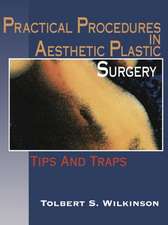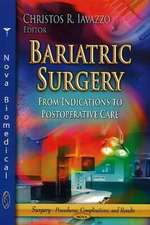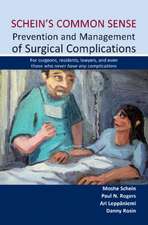Closed Rhinoplasty: The Next Generation
Autor Paul J O'Keeffeen Limba Engleză Hardback – 17 dec 2019
| Toate formatele și edițiile | Preț | Express |
|---|---|---|
| Paperback (1) | 420.53 lei 38-44 zile | |
| Springer International Publishing – 27 dec 2020 | 420.53 lei 38-44 zile | |
| Hardback (1) | 559.98 lei 38-44 zile | |
| Springer International Publishing – 17 dec 2019 | 559.98 lei 38-44 zile |
Preț: 559.98 lei
Preț vechi: 589.45 lei
-5% Nou
Puncte Express: 840
Preț estimativ în valută:
107.19€ • 116.47$ • 90.09£
107.19€ • 116.47$ • 90.09£
Carte tipărită la comandă
Livrare economică 17-23 aprilie
Preluare comenzi: 021 569.72.76
Specificații
ISBN-13: 9783030168513
ISBN-10: 3030168514
Pagini: 135
Ilustrații: IX, 107 p. 173 illus., 168 illus. in color.
Dimensiuni: 178 x 254 x 7 mm
Greutate: 0.45 kg
Ediția:1st ed. 2019
Editura: Springer International Publishing
Colecția Springer
Locul publicării:Cham, Switzerland
ISBN-10: 3030168514
Pagini: 135
Ilustrații: IX, 107 p. 173 illus., 168 illus. in color.
Dimensiuni: 178 x 254 x 7 mm
Greutate: 0.45 kg
Ediția:1st ed. 2019
Editura: Springer International Publishing
Colecția Springer
Locul publicării:Cham, Switzerland
Cuprins
Foreword.- Preface.- 1 Introduction to Closed Nasal Surgery.- 2 Latest Research in Rhinoplasty.- 3 Rhinoplasty Problems and Misconceptions.- 4 Anatomy of the Prominent Nose.- 5 Nasal Surgery and Patients’ Desires.- 6 New Strategy in Closed Rhinoplasty.- 7 Initial Consultation with the Plastic Surgeon.- 8 Planning Session before Surgery.- 9 Instrumentation for Closed Surgery.- 10 Closed Rhinoplasty: The Operation.- 11 Post Operation in Closed Rhinoplasty.
Notă biografică
Paul O’Keeffe graduated from the University of Sydney in 1965 and obtained FRCS (England) in 1971. He trained in plastic surgery in Norwich, before returning to Sydney in 1973, where he obtained FRACS (Plastic Surgery). A consultant plastic surgeon at Royal North Shore Hospital, and at Manly District Hospital in Sydney, founder member of the Australasian Society of Aesthetic Plastic Surgery, and distinguished lecturer at international meetings, he has over 30 years of clinical experience, which he is now developing in private practice.
Textul de pe ultima copertă
The traditional closed rhinoplasty procedure used to produce unstable results, including the “polly beak” deformity, and has largely been replaced by open rhinoplasty, which has now become the new standard. Nevertheless, the complete release of the skin from the nasal skeleton allows for more post-operative swelling, especially if the skeleton is greatly reduced. To enhance nasal definition many surgeons find it necessary to place grafts on the skeleton. This book describes a closed operation that avoids the unstable nose tip of past procedures by preserving the elastic tissue and greatly reduces post-operative swelling. It also presents a novel technique for tip refinement, which elongates the periphery of a dome-shaped tip and a new nose splint. Based on the author's over 30 years of clinical experience and innovations, this step-by-step guide appeals to experienced surgeons wishing to expand their tools and incorporate the advanced techniques described.
Caracteristici
Provides a detailed illustration of anatomical features of the nose that are crucial for a predictable rhinoplasty Guides readers through accurate planning of the surgical intervention and profile template creation for ongoing measurements Includes an in-depth description of a new closed technique, which can be used for major important reductions Presents a step-by-step approach, from the evaluation of the patient to post-operative checks










